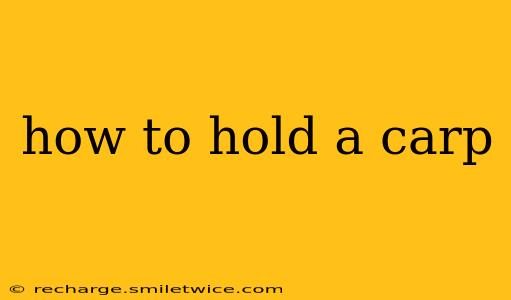Carp, with their powerful bodies and surprisingly delicate features, require careful handling to ensure their safety and well-being. Improper handling can lead to injury, stress, and even death. This guide will detail the best practices for holding a carp, emphasizing ethical and responsible angling.
Why Proper Handling is Crucial
Before diving into the techniques, it's crucial to understand why proper handling is so important. Carp are surprisingly sensitive creatures. Their scales are easily damaged, and their slime coat – a vital protective layer against parasites and disease – can be easily rubbed off. Incorrect handling can leave them vulnerable to infection and reduce their chances of survival. Furthermore, responsible handling demonstrates respect for the environment and ensures the sustainability of the carp population.
How to Hold a Carp: Step-by-Step
The best way to hold a carp minimizes stress and prevents injury. Here's a step-by-step guide:
-
Wet Your Hands: Before touching the carp, thoroughly wet your hands. This prevents the removal of their protective slime coat.
-
Support the Carp's Weight: Use both hands to gently support the carp's entire body. Never hold it solely by its gills or tail.
-
Cupped Hands: Gently cradle the carp in your hands, ensuring its weight is evenly distributed. Your hands should form a supportive cup, preventing it from flopping or twisting.
-
Avoid Lifting the Carp: Try to avoid lifting the carp unnecessarily. If you must lift it, do so with both hands firmly supporting its entire body, keeping it close to the water.
-
Minimize Handling Time: Keep the carp out of the water for the shortest possible time to minimize stress and oxygen deprivation. Handle it quickly and efficiently to unhook it, take photos (if necessary), and return it to the water.
-
Support the Carp During Unhooking: While unhooking the carp, continue to support its weight and maintain a gentle grip.
What Not to Do When Holding a Carp
Avoid these common mistakes:
- Holding by the gills or tail: This can cause severe damage and injury.
- Lifting by the body: Without proper support, you risk damaging its internal organs.
- Leaving it out of water for extended periods: This can lead to stress and oxygen deprivation.
- Gripping too tightly: This can damage scales and remove the protective slime coat.
- Rough handling: Always handle carp gently and respectfully.
Frequently Asked Questions
How long can I hold a carp out of the water?
The shorter the better. Ideally, you should only hold a carp out of the water for the time it takes to unhook it and take any necessary photos. Aim for under 30 seconds.
What if the hook is deeply embedded?
If the hook is deeply embedded, it's best to seek assistance from another angler or a fisheries professional. Attempting to remove it improperly can cause more harm. Consider cutting the line as close to the hook as possible and allowing the hook to work its way out naturally.
Should I wet my hands even if they are already damp from the water?
Yes. Even damp hands can still remove the vital slime coat. Ensuring your hands are thoroughly wet is always best practice.
Can I take pictures holding the carp?
While pictures can be tempting, keep the handling time to an absolute minimum. Consider placing the carp on a wet mat for quick photography. Always prioritize the well-being of the fish.
Is it okay to hold a carp while weighing it?
Weighing a carp requires specialized equipment that minimizes handling and stress, such as a sling or a weigh mat designed for fish. Avoid using traditional scales that involve removing the fish from the water and placing it on the scale.
By following these guidelines, you can enjoy the thrill of catching a carp while ensuring its well-being and contributing to responsible angling practices. Remember, respecting the fish is crucial for maintaining healthy populations for years to come.
